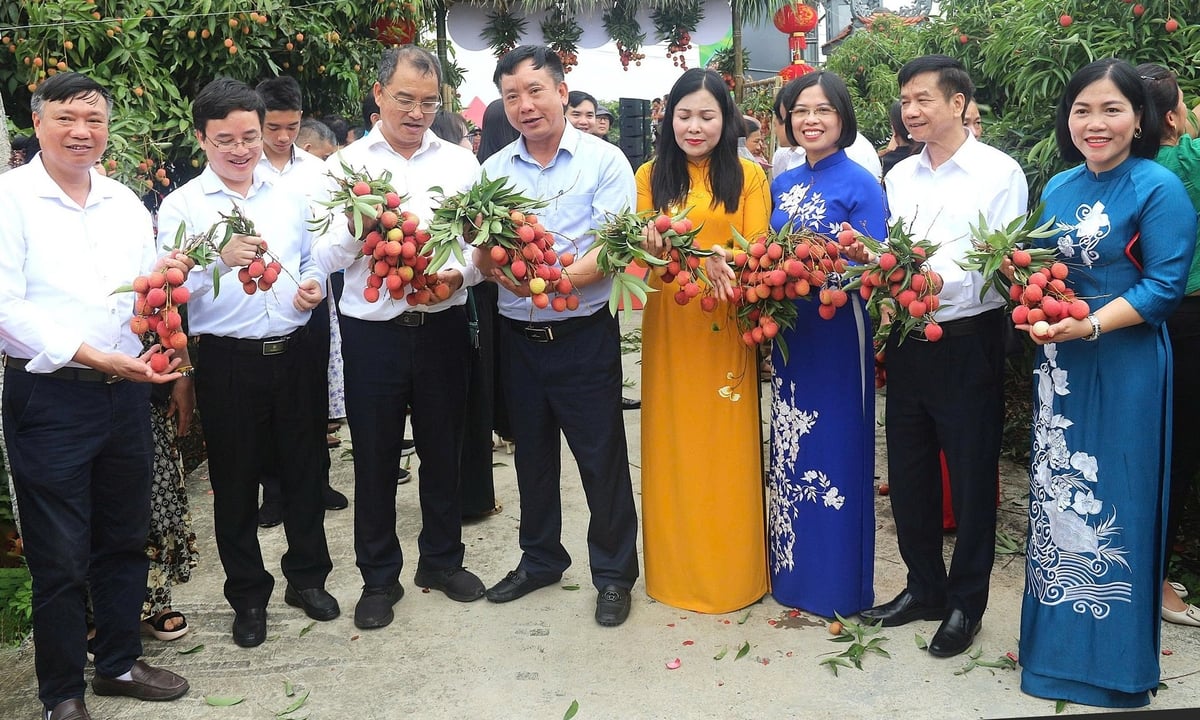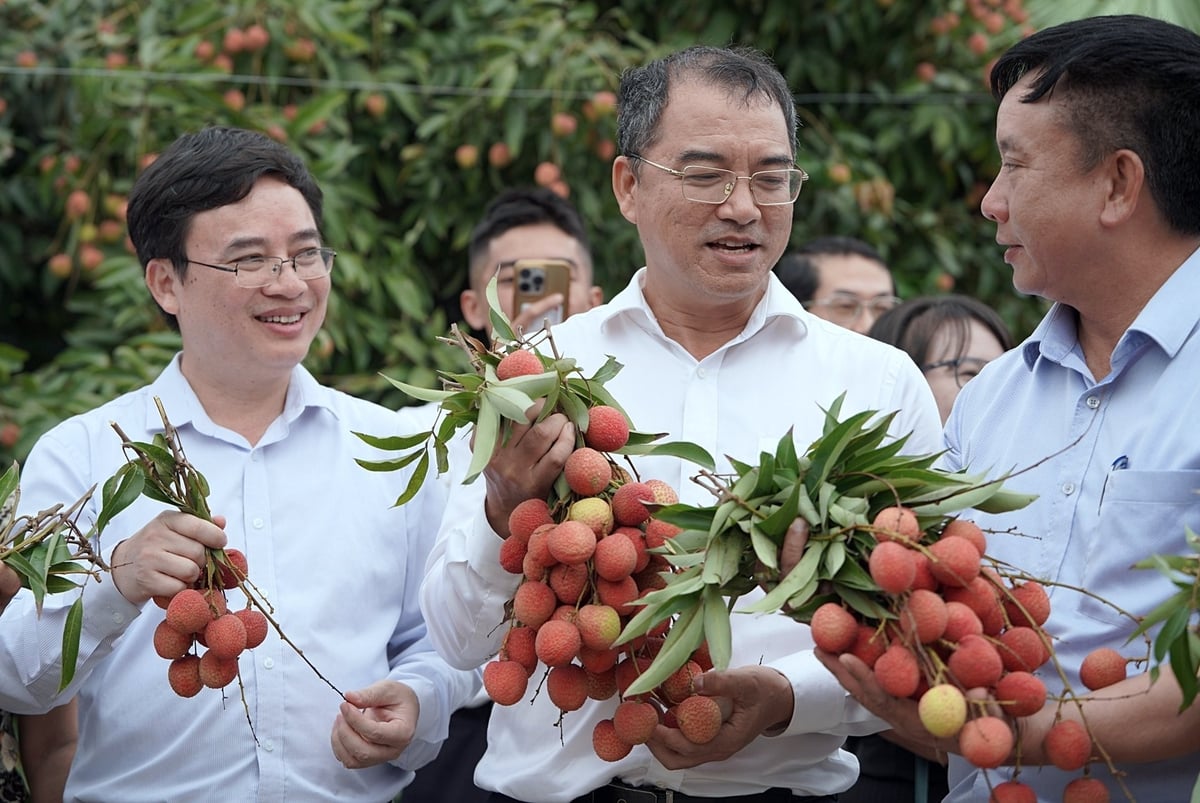December 31, 2025 | 10:44 GMT +7
December 31, 2025 | 10:44 GMT +7
Hotline: 0913.378.918
December 31, 2025 | 10:44 GMT +7
Hotline: 0913.378.918
A memorandum of understanding for the 2025 lychee purchasing season has just been signed between companies such as Ameii Vietnam, Rong Do (Red Dragon), and several cooperatives with large production volumes in Thanh Ha district, including Thanh Thuy and Hop Duc.
This move continues a series of activities aimed at promoting local agricultural products in international markets. It took place during the Thanh Ha Lychee Trade Promotion Conference with Vietnam’s commercial counselors and foreign enterprises on the morning of May 30.

Representatives of businesses and cooperatives sign product consumption contracts. Photo: Pham Hieu.
According to the agreement, fresh lychees meeting GlobalGAP, VietGAP, or equivalent standards from growing areas with registered codes will be guaranteed for purchase, aiming for export to high-end markets such as Japan, the United States, the EU, New Zealand, and others.
The purchase price will be based on the timing of the agreement and market fluctuations, and can be adjusted in writing if necessary.
Mr. Nguyen Khac Tien, Chairman of the Board of Directors of Ameii Vietnam Joint Stock Company, stated that the entire process of care, harvesting, preliminary processing, and packaging must strictly comply with regulations. Lychees must be trimmed at the stem according to guidelines and packed in plastic trays or foam boxes with a logo and traceability labels.
In addition, the fruit must be uniform, pest-free, and meet the required ripeness and sweetness levels. The rate of lychees meeting export standards must not fall below 97.5%.
Company representatives also committed to closely cooperating with cooperatives in supervising cultivation processes and conducting quality sample tests 7–8 days before each harvest. Any products that do not meet quality standards or are not delivered on schedule will not be accepted.
Mr. Doan Van Hung, Director of Thanh Thuy Agricultural Services Cooperative, stated: “Signing contracts early gives farmers peace of mind during production and helps enhance the value of Thanh Ha lychees through standardized output.”
Ameii Vietnam Joint Stock Company is one of the pioneering enterprises in exporting fresh fruit to demanding markets. In recent years, the company has continuously worked with localities to establish growing area codes, provide cultivation technique training, and support traceability practices for farmers.

Central and Hai Duong provincial leaders visit the Thanh Ha lychee region. Photo: Pham Hieu.
According to statistics from the Hai Duong Department of Agriculture and Environment, the province is expected to produce around 30,000 tons of lychee in 2025, with the majority being early-harvest lychees from Thanh Ha district. In order to boost consumption amid intense competition, the province has been actively connecting with the Vietnamese trade offices abroad and coordinating the organization of lychee promotion weeks at supermarket chains and cross-border e-commerce platforms.
Many export enterprises have proactively secured early purchasing agreements and built sustainable production and distribution chains. This is considered an important strategy for Thanh Ha lychees to expand their market, increase value, and maintain their position on Vietnam’s fruit export map.
Mr. Tang Ba Bay, Chairman of the Thanh Ha District People’s Committee, remarked that the event was flexibly organized in a hybrid format - both in-person and online - across multiple domestic and international locations, attracting a large number of businesses, regulatory agencies, and trade support organizations.
The conference aimed to connect producers, government agencies, and distribution/export enterprises, thereby promoting the consumption and market expansion of key agricultural products, especially Thanh Ha lychees.
According to Mr. Bay, information shared by overseas Trade Offices regarding policies, tax rates, and technical barriers provides an important foundation for Hai Duong businesses to assess their supply capacity, choose appropriate strategies, and reorient their target markets.
This also presents an opportunity for enterprises to promote their signature products, strengthen partnerships, and seek sustainable market access in the international arena.

The 2025 Thanh Ha lychee crop is rated as a bumper harvest. Photo: Bao Thang.
The Chairman of Thanh Ha District also called on the business community to focus on investing in technology, improving product design, and enhancing product quality to better meet global consumer demands. Proactively participating in international trade fairs, building market-appropriate brands, and applying transparent trade standards will be key factors in minimizing risks and improving export efficiency.
He believes that, with solidarity spirit, the support of ministries and agencies, and efforts from businesses, the production and consumption of agricultural products, especially lychees, will continue to achieve positive results in the near future.
At the conference, Mr. Hoang Minh Chien, Deputy Director of the Vietnam Trade Promotion Agency, affirmed that the Ministry of Industry and Trade is implementing a range of coordinated activities to support trade connections and expand export markets.
In particular, Thanh Ha lychee is a key agricultural product with competitive potential in demanding markets such as the EU, the United States, and Japan. Amid global economic fluctuations, promoting agricultural consumption through value chains and local brand positioning is a crucial strategy to enhance sustainable export value.
Translated by Phuong Linh
/2025/12/29/2812-1-182339_699.jpg)
(VAN) The price of mangrove forest carbon credits is high because this forest type not only delivers significant environmental value but also plays a crucial role in addressing other issues.
/2025/12/29/5840-0-115141_514.jpg)
(VAN) From 2026, many EU markets will require shrimp to be electrically stunned before ice immersion, forcing exporters to change technologies to retain market share.
/2025/12/28/4951-2-104623_113.jpg)
(VAN) Rubber exports are forecast to remain under downward pressure in the coming period, as global rubber consumption shows signs of slowing, according to ANRPC's projections.
/2025/12/28/5120-1-093308_94.jpg)
(VAN) Many agricultural products are of sufficient quality to join global supply chains, yet fail to pass the first gateway when entering international markets due to packaging and information in English.
/2025/12/27/2453-2-172141_426.jpg)
(VAN) The sharp decline in the number of EU warnings in 2025 is regarded as a positive signal for the future orientation of Viet Nam’s agricultural exports.
/2025/12/27/1547-2-220434_536.jpg)
(VAN) For many businesses, exporting is a costly trial. But for those choosing a long-term path, small orders are a way to keep markets and learn the rules.
/2025/12/27/2522-1-090748_662.jpg)
(VAN) The 'Large-Scale Rice Field' project has been implemented in An Giang across a total area of more than 5,582 ha, comprising 73 large-scale fields and attracting the participation of 2,027 farmer households.